 by "ttyymmnn" (ttyymmnn)
by "ttyymmnn" (ttyymmnn)
Published 05/19/2017 at 12:35
 by "ttyymmnn" (ttyymmnn)
by "ttyymmnn" (ttyymmnn)
Published 05/19/2017 at 12:35
Tags: Planelopnik
; planelopnik history
STARS: 7
Welcome to This Date in Aviation History , getting you caught up on milestones, important historical events and people in aviation from May 17 through May 19.
!!! UNKNOWN CONTENT TYPE !!!

May 17, 1943 – The crew of the Memphis Belle completes its 25th and final mission. In 1935, Boeing performed the maiden flight of their new, four-engined bomber which they called the Model 299. The huge bomber bristled with five .30 caliber defensive machine guns, so many for its day that a reporter for the Seattle Times described it as Boeing’s new “Flying Fortress,” because surely, this new bomber would be impervious to enemy attack. Boeing liked the name, trademarked it, and the legendary Boeing B-17 Flying Fortress was born. In practice, however, the Flying Fortress was clearly not impregnable. By the time the 8th Air Force began bombing missions into German-occupied Europe, and though the defensive armament had increased to 10 machine guns, or more, the lack of escort fighters to protect the lumbering bombers meant that they were easy prey for German fighters and sitting ducks for highly accurate flak ( flak is an acronym for Fliegerabwehrkanone , or anti-aircraft artillery). Add to that the fact that the American bombers flew their missions during daylight hours to increase accuracy, and the Flying Fortress began to suffer horrible losses of planes and crews. In October 1943 alone, the 8th Air Force lost 176 bombers, more than 5 per day. The aircrews, made up mostly of boys barely 18 years old and flown by pilots who were only in their 20s, were expected to fly 25 missions to complete their tour. But with an average loss rate of 8-percent of the bombers per mission at that time, the odds were very poor that a single crew would fly all of their missions and return safely without the loss of even one man. Throughout the war, the number of missions needed to complete a tour fluctuated depending on need and risk assessment, sometimes going as high as 35. This was still an arbitrary number, but it gave the crews something to look forward to, a light at the end of a tunnel filled with fighters and flak that just might be attainable. Still, over 3,000 B-17s were lost in the war, and though the advent of long-range escort fighters in the second half of the war helped fend off the German attackers, flak always took its toll. Despite those terrible odds, there were bombers and crews that managed to complete their tour, and one that did so famously (though not first—see author’s note below), was the Memphis Belle .

The Belle was a B-17F (serial number 41-24485) assigned to the 324th Bombardment Squadron (Heavy), 91st Bombardment Group and was commanded by Captain Robert Morgan . Flying from Bassingbourn, Scotland, the Belle and her crew carried out its first mission on November 7, 1942 against targets in Brest, France, and flew the majority of their missions over Brittany, with some missions to the Netherlands and a handful into Germany. Throughout its tour, the Belle was shot up numerous times by fighters and punctured by flak. She went through nine engines, had both wings replaced, had the tail replaced twice, and both landing gear assemblies were replaced. But her luck held, and as her 25th mission approached, the US Army Air Corps saw an opportunity to generate some positive news for the home front. The Army dispatched a film crew, directed by famous director and producer William Wyler , to make a full-color documentary of the final flight titled Memphis Belle: The Story of a Flying Fortress which was released to the American public in 1944.* Following the Belle’s final mission, the plane and her crew flew back to the US, where they toured the country to help sell war bonds and to boost the nation’s morale. Following the war, the crew returned to life in the US, and the final member of the crew, top turret gunner Harold Loch, passed away in October 2004. Soon after the end of the war in 1945, the Memphis Belle was rescued from reclamation and purchased by the City of Memphis for $350. After flying her to Memphis, the city displayed the bomber outdoors into the 1980s, where it slowly deteriorated and was eventually stripped of almost all her internal components by souvenir hunters. Finally, in 2004, the aircraft was transferred to National Museum of the United States Air Force in Dayton, Ohio, where it is preserved and is undergoing restoration. Hollywood also produced a dramatic film about the plane and her crew, The Memphis Belle , which was released in 1990. (US Air Force photos)
* As was the practice at the time, the crews and the planes were often interchangeable. So, while the crew completed its 25th mission on May 17, 1943 while bombing the submarine pens at Lorient, France, the
Belle
completed her 25th mission two days later with a different crew. Morgan’s crew completed four of its missions in four different aircraft.
!!! UNKNOWN CONTENT TYPE !!!
Author’s note:
The
Memphis Belle
and her crew garnered much notoriety for the completion of 25 missions, due in large part to the documentary about their final mission. However, the
Belle’s
crew was not the first B-17 crew to complete their tour. That distinction goes to the crew of
Hell’s Angels
(B-17F, serial number 41-24577), which completed its 25th mission on May 13, 1943, six days ahead of the
Belle
. However, the crew of the
Belle
was the first to be sent back to the US because the crew of
Hell’s Angels
signed on for another tour and eventually flew a total of 48 missions before returning to the US in 1944. Bu
Hell’s Angels
still wasn’t the first bomber to reach the mission milestone. The crew of the
Consolidated B-24 Liberator
Hot Stuff
completed its 25th mission on February 7, 1943, three-and-a-half months ahead of the
Belle
, then flew another six missions before returning to the US. While the
Belle
wasn’t the first to complete its tour, it is certainly the most well known, and its fame is likely a simple matter of fate—or Army record keeping. It’s unclear why the
Belle
was chosen for such publicity, but regardless, she and her crew serve as a testament to the courage of thousands of young men who flew into harm’s way, many of whom did not return.
!!! UNKNOWN CONTENT TYPE !!!
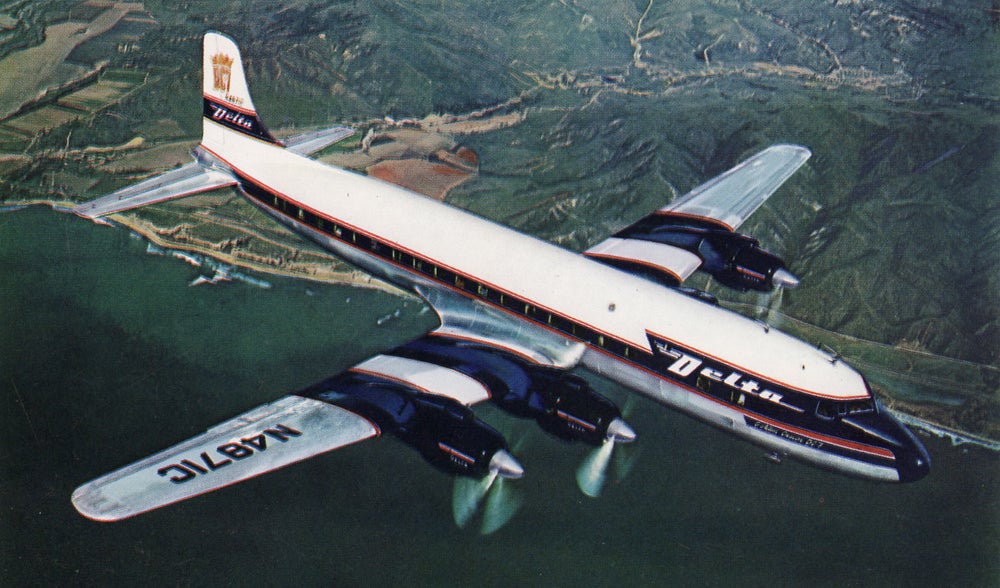
May 18, 1953 – The first flight of the Douglas DC-7. During WWII, piston-powered aircraft design reached its zenith, and with the coming of the jet engine at the end of the war, it was only a matter of time before jet power supplanted piston power in the airline industry. But in the early post-war period, turbojets were still relatively new, and airlines were reluctant to plunge headlong into the new technology. The piston powered airliner still had more miles to fly, though for the Douglas Aircraft Company , the DC-7 would be the piston engine’s last hurrah. As the range of the modern airliner increased, companies like American Airlines wanted to provide nonstop, coast-to-coast service. But they ran afoul of Civil Air Regulations that dictated that flight crews could not fly for more than 8 hours in one 24-hour period, and that was not enough time to complete the trip. So American needed a faster plane. When American Airlines president C.R. Smith ordered 25 aircraft—and agreed to pay the $4o million development cost—Douglas committed to developing the DC-7, their last piston airliner before the jet-powered DC-8 which would take its first flight just 5 years after the DC-7. Sticking with a trusted engine also meant adhering to the design elements that had served Douglas so well in the past. Douglas based the DC-7’s wing on that of the DC-4 , and the fuselage was essentially that of the DC-6 but stretched to accommodate more passengers. The DC-7 was powered by the Wright R-3350 Duplex-Cyclone , a twin-row, 18-cylinder radial engine that was used in a host of other aircraft, including the Boeing B-29 Superfortress and Lockheed Super Constellation . Just 6 months after the DC-7's first flight, American Airlines began offering nonstop service flying from the west coast of the United States to the east coast, scheduling the flights for just under the required 8 hours, even if actual conditions didn’t always permit that. Weather always played a factor, and the DC-7 was plagued with engine reliability problems which caused frequent diversions and delayed flights. Nevertheless, the range and speed of the DC-7 was attractive to the airlines, and, particularly with the DC-7B, which added still more power and range, it proved popular with American carriers who scheduled east-to-west service from the US to Europe. However, it remained unattractive to European airlines because the range was still insufficient for west-to-east transatlantic crossings. Douglas responded with the DC-7C (nicknamed Seven Seas), a variant that moved the engines a bit farther outboard on the wings to reduce cabin noise and provide for yet more fuel, and the fuselage was stretched once again to make room for more seats.
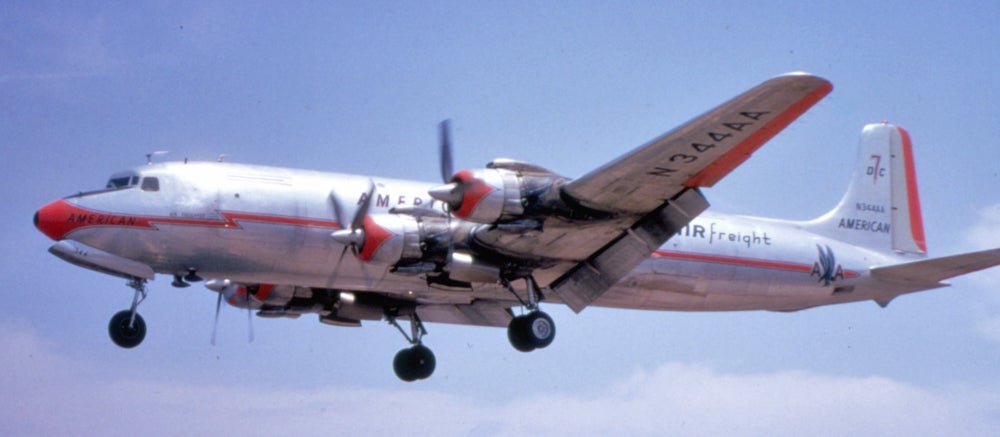
Despite the transatlantic range and relative reliability of the DC-7C, the days of the piston-powered airliner were coming to an end. With the advent of the Boeing 707 and Douglas’ own DC-8, sales of the DC-7 ground to a halt by the end of the 1950s. But the DC-7 still had lots of life in it. Douglas converted the earlier DC-7s and DC-7Cs into the DC-7F, a freighter variant that came with cargo doors added to the front and rear. Douglas produced the DC-7 from 1953-1958, only building a 343, roughly half the number of DC-6s they produced, a low production number that is as much a matter of timing as anything else, coming as it did at the end of the piston era. Due perhaps to engine reliability issues, only a handful of DC-7s are still flying today. (Photo author unknown; photo by Bill Larkins via Wikimedia Commons )
!!! UNKNOWN CONTENT TYPE !!!
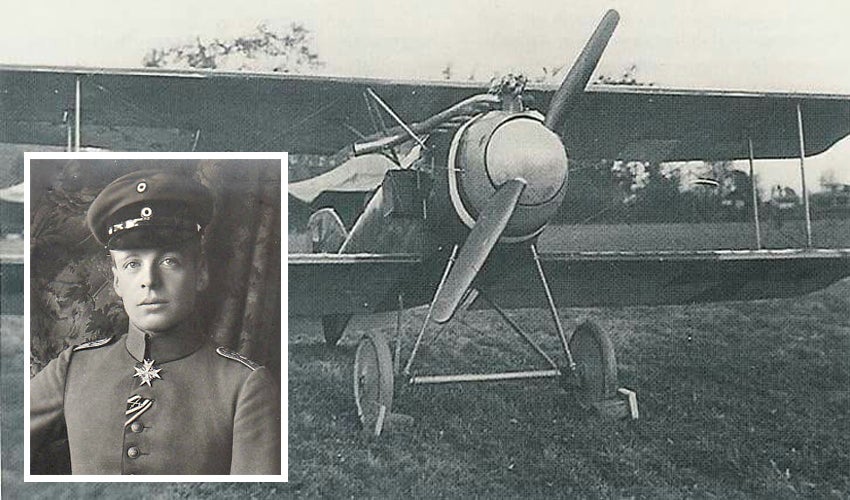
May 19, 1891 – The birth of Oswald Boelcke.
When WWI broke out in Europe in 1914, only 11 years had passed since the
Wright Brothers
took the first powered flight at Kitty Hawk, North Carolina. But aircraft development in the intervening years had been rapid, and it wasn’t long before airplanes were appearing over the battlefield. At first, they were scout planes, providing reconnaissance on enemy positions in a similar fashion as the original scouts on horseback, and opposing pilots often passed each other with a friendly wave. But it wasn’t long before the pilots and scouts began taking pistols and rifles into the air, which then gave way to machine guns. Soon, scout planes had become dedicated fighter planes, and pilots wheeled and turned in combat in the rarefied air high above the mud and blood of the trenches. At first, aerial combat was very much a one-on-one affair, with lone pilots ranging across enemy lines seeking out an opponent. But it quickly became evident that groups of aircraft were more effective than a single fighter, and one man, Oswald Boelcke, was the first to codify the tactics of aerial combat. Bolcke was born in Giebichenstein in Eastern Germany, and joined the military in 1911, eventually becoming an officer in the Prussian Army. He started flying in 1914, and by 1915 he was assigned to an observer unit. Before long, Boelcke, along with three other pilots, among them
Max Immelmann
, received a new
Fokker E.I
fighter that had a machine gun synchronized to fire through the propeller. Along with his comrades, Boelcke soon became an ace, and eventually lead his own fighter squadron. He also tutored
Manfred von Richthofen
, better known as The Red Baron. But Boelcke’s most lasting contribution to combat aviation came in his list of fighter tactics known as
Dicta Boelcke
. Contrary to the single combat practiced at the beginning of the war, Boelcke advocated fighting in groups, and many of his tenets still hold true to this day.
Try to secure advantages before attacking. If possible, keep the sun behind you.
Always follow through an attack when you have started it.
Fire only at close range, and only when your opponent is properly in your sights.
Always keep your eye on your opponent, and never let yourself be deceived by ruses.
In any form of attack it is essential to assail your opponent from behind.
If your opponent dives on you, do not try to evade his onslaught, but fly to meet it.
When over enemy lines, never forget your line of retreat.
For the
Jasta
(squadron): Attack in groups of four or six. When the fight breaks up into a series of single combats, take care that several do not go for one opponent.
Obviously, in the modern age of beyond visual range (BVR) missiles and radar, some of these tactics must be modified. But the concepts of placing the sun at your back, never fighting without a wingman, and keeping sight of your opponent still hold true today. As tactics evolved into the Second World War, Dicta Boelcke served as the basis for others to expand upon, such as the RAF ace Edward “Mick” Mannock with his set of 15 rules, and RAF pilot and ace Adolph Malan , who had his own set of ten rules, again expanding on the groundbreaking work of Boelcke. There is a famous axiom in the world of fighter pilots: “There are old pilots, and there are bold pilots, but there are no old, bold pilots.” Such was the fate of Oswald Bolcke, who was bold, but did not grow old. On October 28, 1916, Boelcke set out on his sixth sortie of the day with five other pilots, including two of his brightest students, Manfred von Richthofen and Erwin Böhme . While attacking a British de Havilland DH.2 fighter, Bolcke and Böhme collided. Bolcke managed to land, but his improperly secured lap belt did not restrain him, and he was killed. Boelcke was only 25 years old. (Photo authors unknown)
!!! UNKNOWN CONTENT TYPE !!!
!!! UNKNOWN CONTENT TYPE !!!
!!! UNKNOWN CONTENT TYPE !!!
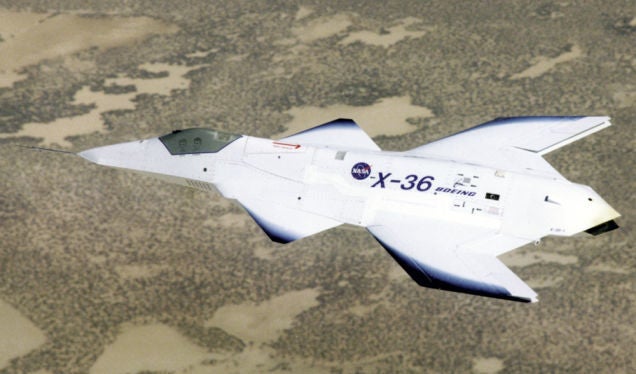
May 17, 1997 – First flight of the McDonnell Douglas X-36, an experimental tailless aircraft built by McDonnell Douglas (later Boeing) to explore flight by an aircraft without a traditional vertical tail assembly. Built at 28-percent scale of a possible manned fighter, the X-36 was controlled by a pilot on the ground and maneuvered via flight controls provided by a forward canard , split ailerons (also called a deceleron ), and vectored thrust . The X-36 made 31 successful research flights, and while the aircraft performed beyond expectations, displaying excellent maneuverability and stability, development ceased following the successful test program. Two prototypes were built, and one resides at the National Museum of the United States Air Force , while the other is on display at the Air Force Test Flight Center Museum at Edwards AFB . (NASA photo)
!!! UNKNOWN CONTENT TYPE !!!
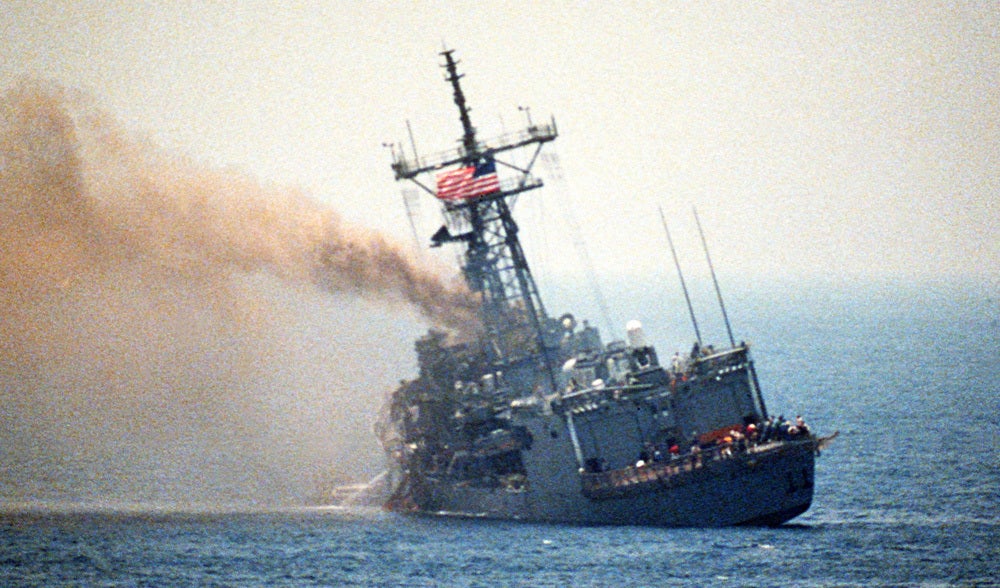
May 17, 1987 – An Iraqi fighter fires two missiles into the frigate USS
Stark
.
During tensions in the Persian Gulf in the 1980s, the US Navy assumed the task of patrolling the Gulf, particularly the strategic
Strait of Hormuz
, to ensure the safe passage of cargo ships in the embattled region. For reasons that remain disputed, an Iraqi
Dassault Mirage F1
fired two French-made
Exocet
anti-ship missiles at the
Stark
(FFG-31). The first missile penetrated
Stark
just above the waterline but did not explode, while the second entered the ship and detonated in the crew quarters, killing 37 sailors and injuring 21. The
Stark’s
crew failed to detect either the aircraft or the missiles until it was too late, and no defensive countermeasures were taken to stop attack. The Iraqis claimed that
Stark
was in its territorial waters, but the US Navy held that the frigate was in international waters at the time. Facing courts-martial following the incident,
Stark’s
captain and her Tactical Action Officer both chose early retirement.
(US Navy photo)
!!! UNKNOWN CONTENT TYPE !!!
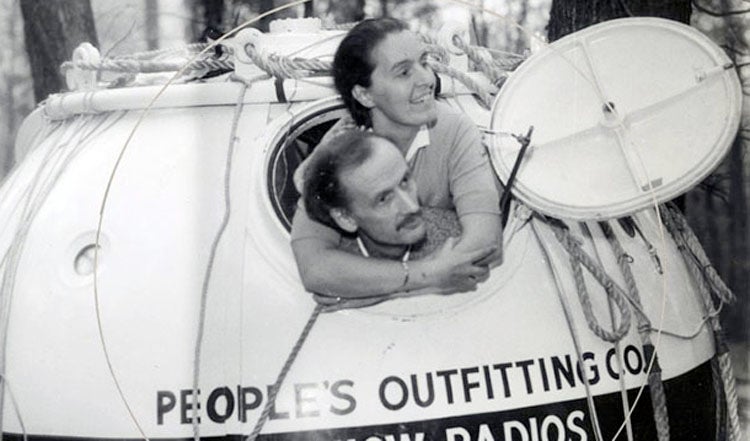
May 17, 1981 – The death of Jeannette Piccard. Piccard (née Ridlon) was born on January 5, 1895 in Chicago, Illinois and studied philosophy, psychology and biology at Bryn Mawr College and the University of Chicago before marrying scientist and balloonist Jean Piccard in 1919. Jean had made a name for himself in Belgium for his flights into the stratosphere, and Jeanette became the first licensed balloon pilot in the United States. On October 23, 1934, Jean and Jeannette flew to an altitude of 10.9 miles, an altitude record for women that Jeannette held for 30 years. Later, Jeannette worked as a consultant for NASA’s Johnson Space Center , and finished her life as an Episcopal priest. For her stratospheric flight, Jeannette Picard was posthumously inducted into the International Space Hall of Fame in 1998, and is considered by some to be the first woman in space. (Photo author unknown via NASTAR Center )
!!! UNKNOWN CONTENT TYPE !!!

May 17, 1964 – The death of John Moore-Brabazon, 1st Baron Brabazon of Tara. Moore-Brabazon was born in London on February 8, 1884, and learned to fly in 1908. He became the first Englishman to make a recognized flight in England, and became the first licensed aviator in England, receiving the Royal Aero Club Aviator’s Certificate No. 1. During WWI, Moore-Brabazon played a prominent role in the development of aerial reconnaissance, and became a Member of Parliament after the war. Beginning in late 1942, he chaired the Brabazon Committee , which was formed to investigate the postwar future of the English airline industry. Some of the most important aircraft of the postwar period came from the committee’s work, including the Vickers Viscount , Avro Tudor , and de Havilland Comet , the world’s first jet-powered airliner. The committee also directed the construction of the mammoth Bristol Brabazon airliner (above), although only one was ever built. (Lord Brabazon photo by Walter Stoneman via the National Portrait Gallery ; Bristol Brabazon photo author unknown)
!!! UNKNOWN CONTENT TYPE !!!

March 17, 1948 – The first flight of the turboprop-powered Boulton Paul Balliol. Development of the Balliol was initiated in 1945 with Air Ministry Specification T.7/45 to find a turboprop-powered training aircraft to replace the North American Harvard (T-6 Texan in US service). The prototype aircraft first flew on May 30, 1947 powered by a Bristol Mercury 30 radial engine, but the second prototype was powered by an Armstrong Siddeley Mamba turboprop, and when the Mamba-powered Balliol took its maiden flight it became the world’s first turboprop-powered aircraft to take to the air. However, the Air Ministry changed its requirements in 1947, and the Mamba was replaced in production aircraft by the Rolls-Royce Merlin piston engine. (Photo author unknown via 1000aircraftphotos.com )
!!! UNKNOWN CONTENT TYPE !!!
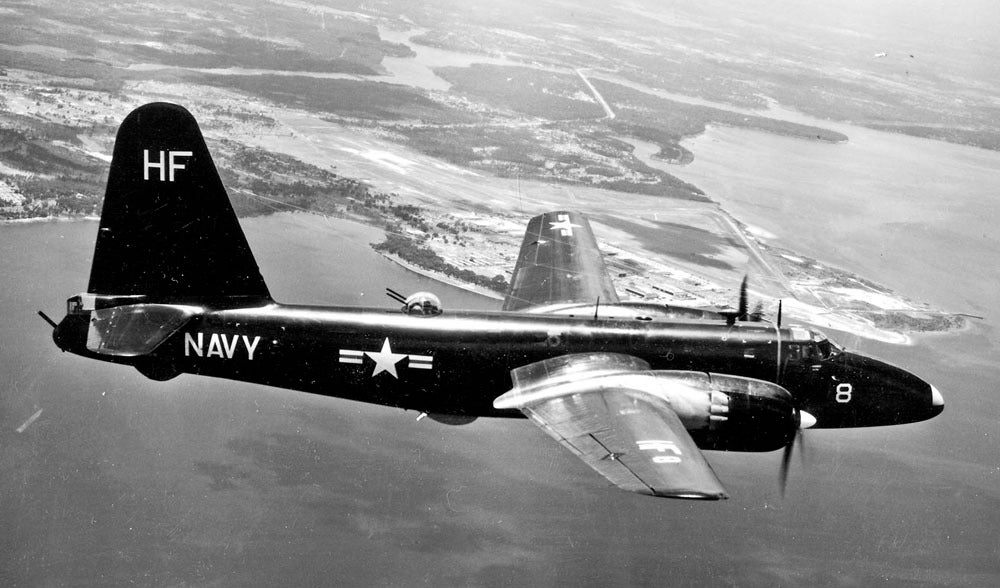
May 17, 1945 – The first flight of the Lockheed P-2 Neptune, a maritime patrol and anti-submarine (ASW) aircraft developed to replace the Lockheed PV-1 Ventura/PV-2 Harpoon . The P-2 entered service in 1947 and was the first aircraft to be fitted with both piston and jet engines, with both types of engine running on the same fuel to save space and limit complexity. Despite the Neptune’s maritime/ASW mission, small numbers of Neptunes were deployed as carrier-based nuclear bombers as a stop-gap measure until dedicated nuclear bombers could be developed. In 1946, a modified Neptune nicknamed Truculent Turtle flew from Perth, Australia to Columbus, Ohio, setting an unrefueled distance record of 11,236 miles, a record for piston-powered flight that was not broken until the Rutan Voyager flew around the world nonstop in 1986. Replaced by the Lockheed P-3 Orion , Neptunes were retired from military service in 1984, though many still fly as civilian firefighters. (US Navy photo)
!!! UNKNOWN CONTENT TYPE !!!

May 18, 1969 – The launch of Apollo 10,
the fourth manned mission of the
Apollo Program
and the second to orbit the Moon. Apollo 10 served as a dress rehearsal for the
Apollo 11
mission that successfully landed on the Moon two months later. After establishing orbit 70 miles above the Moon, astronaut
John Young
, who would later command the first flight of the Space Shuttle, remained in the
Command Module
while mission commander
Thomas Stafford
and
Lunar Module
pilot
Eugene Cernan
descended to within 8.4 nautical miles of the Moon’s surface. On its return from the Moon, Apollo 10 set a world record for the highest speed attained by a manned vehicle, flying at 24,791 mph before successfully splashing down in the Pacific Ocean on May 26.
(NASA photo)
!!! UNKNOWN CONTENT TYPE !!!
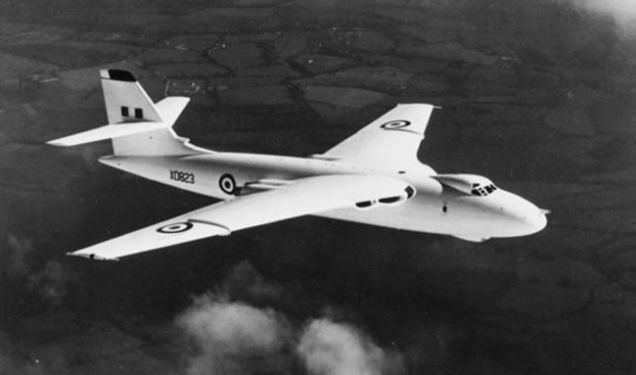
May 18, 1951 – The first flight of the Vickers-Armstrong Valiant,
a four-engine, high-altitude nuclear bomber and the first of the so-called V bombers (along with the
Handley Page Victor
and the
Avro Vulcan
). Designed as a strategic bomber, the Valiant suffered from fatigue cracks that would also plague the other V bombers, and its service life was relatively short, and it was supplanted by its more advanced successors. Before its retirement, the Valiant carried out nuclear deterrence missions, conventional bombing, and aerial reconnaissance. Some Valiants were also converted as aerial tankers. A total of 107 were built, and the Valiant was formally retired in 1957.
(Photo author unknown)
!!! UNKNOWN CONTENT TYPE !!!
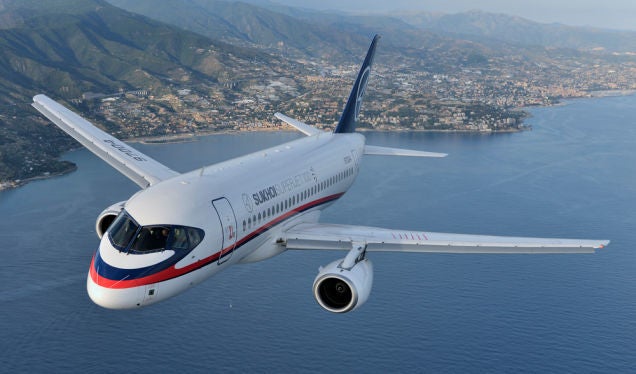
May 19, 2008 – The first flight of the Sukhoi Superjet 100, a twin-engine, fly-by-wire airliner designed to compete with the Antonov An-148 and similarly sized aircraft built by Bombardier and Embraer. The Superjet 100 is powered by a pair of PowerJet SaM146 turbofan engines built as a partnership between Snecma of France and NPO Saturn of Russia, and can carry up to 108 passengers in a dense, single-class configuration. The airliner made its first passenger flight on April 21, 2011, and while it is difficult to determine the exact number of orders and deliveries, Malév Hungarian Airlines indicated in 2009 that it would purchase 30 aircraft. A total of 104 aircraft have been delivered against orders for 384 airliners. (Photo by Katsuhiko Tokunaga via Wikimedia Commons )
!!! UNKNOWN CONTENT TYPE !!!
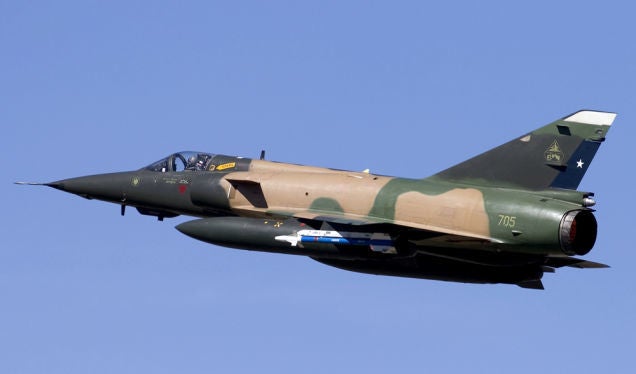
May 19, 1967 – The first flight of the Dassault Mirage 5, a supersonic, delta wing attack jet that was derived from the Dassault Mirage III by Dassault Aviation . The Mirage 5 was developed by request of the Israeli Air Force, who believed that removing avionics from behind the cockpit would allow for more fuel for long-range attack missions. Due to tensions in the Middle East, the French government refused to deliver the fighters to Israel, though they eventually received them through outside sources. The Mirage 5 was also developed into reconnaissance and two-seat variants, and proved popular with export customers, serving in the air forces of 15 nations. A total of 582 were built, and the Israelis eventually used the Mirage 5 as the basis for the domestically-built IAI Kfir fighter . (Photo by Chris Lofting via Wikimedia Commons )
!!! UNKNOWN CONTENT TYPE !!!
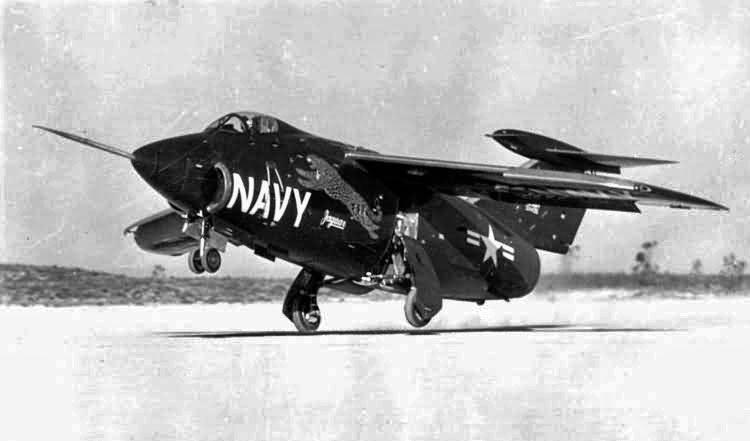
May 19, 1952 – The first flight of the Grumman XF10F Jaguar, a prototype variable-geometry fighter developed for the US Navy. As fighter design progressed into the 1950s, the trend was moving towards larger, heavier aircraft with greater speed. While swept wings were good for high speed, they weren’t well-suited to low-speed landings, particularly on the straight decks of carriers of the day. Grumman devised an aircraft that could straighten the wings for landing and takeoff, while sweeping the wings back for high-speed flight. The Jaguar was hampered by unreliable engines and poor flight characteristics, and the development of larger carriers with angled flight decks rendered the concept unnecessary. However, much of what was learned with the Jaguar was later used on the extraordinarily successful Grumman F-14 Tomcat . (US Navy photo)
!!! UNKNOWN CONTENT TYPE !!!
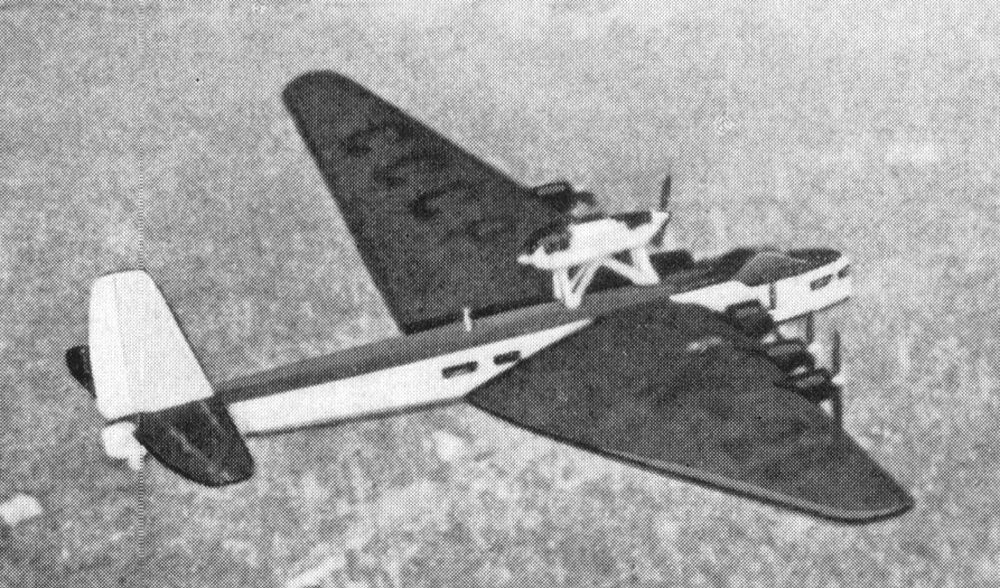
May 19, 1934 – The first flight of the Tupolev ANT-20 Maxim Gorky, an eight-engine transport aircraft and one of the largest aircraft of its era. Its wingspan was nearly that of the modern Boeing 747-400 jumbo jet, and it remained the largest aircraft until the arrival of the Douglas XB-19 long range bomber. Named after Maxim Gorky , a Russian and Soviet writer and founder of socialist realism , the ANT-20 was an all-metal aircraft based on the construction techniques pioneered by Hugo Junkers in WWI, and was intended to be used as a Soviet propaganda office outfitted with a powerful radio, printing presses, a library and a movie projector. A second aircraft was built after the first crashed, killing 45 people, though it was powered by six more powerful engines. It, too, crashed when the pilot allowed a passenger to take the controls and the passenger unwittingly disengaged the autopilot. All 36 passengers were killed.
!!! UNKNOWN CONTENT TYPE !!!
!!! UNKNOWN CONTENT TYPE !!!
!!! UNKNOWN CONTENT TYPE !!!
!!! UNKNOWN CONTENT TYPE !!!
!!! UNKNOWN CONTENT TYPE !!!
!!! UNKNOWN CONTENT TYPE !!!
!!! UNKNOWN CONTENT TYPE !!!
If you enjoy these Aviation History posts, please let me know in the comments. And if you missed any of the past articles, you can find them all at Planelopnik History . You can also find more stories about aviation and aviators at Wingspan and Planes You’ve (Probably) Never Heard Of .
!!! UNKNOWN CONTENT TYPE !!!
 "For Sweden" (rallybeetle)
"For Sweden" (rallybeetle)
05/19/2017 at 12:38, STARS: 2
pssh B-25 crews in the 256th Bomb Group are flying over 70 missions!
 "Ash78, voting early and often" (ash78)
"Ash78, voting early and often" (ash78)
05/19/2017 at 12:43, STARS: 0
I think I’m slightly more impressed that ANY B-24 was able to complete 25 missions, considering those things would burst into flames if you looked at them wrong. Meanwhile, the B-17 could limp home with chunks of a FRICKING GERMAN FIGHTER wedged into the side, after nearly severing the entire tail section.
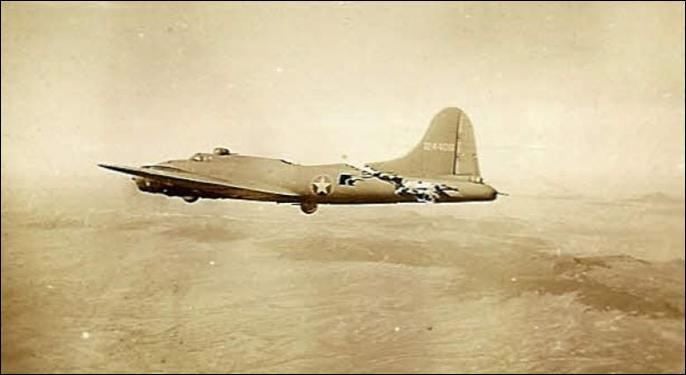
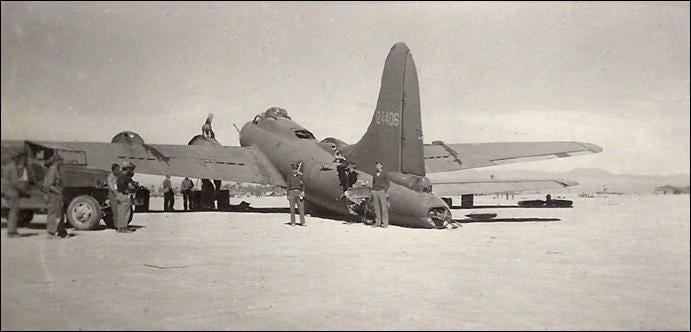
 "ttyymmnn" (ttyymmnn)
"ttyymmnn" (ttyymmnn)
05/19/2017 at 12:46, STARS: 1
I’d say that they don’t build ‘em like they used to, but then there’s this.
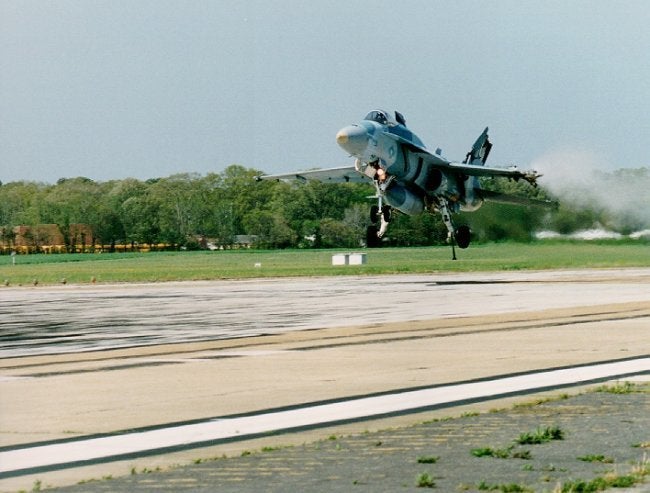
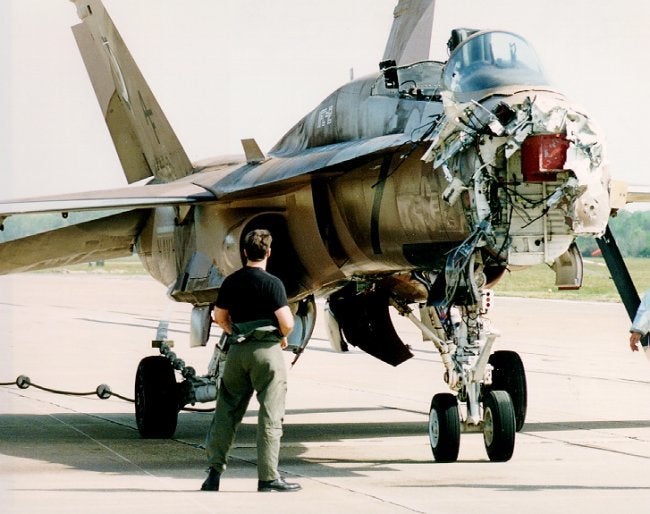
http://www.aircraftresourcecenter.com/Stories1/001-100/0011_F-18_Mid-air/story0011.htm
 "For Sweden" (rallybeetle)
"For Sweden" (rallybeetle)
05/19/2017 at 12:47, STARS: 4
There’s a simple explanation: Ford built many B-24s.
 "Ash78, voting early and often" (ash78)
"Ash78, voting early and often" (ash78)
05/19/2017 at 12:48, STARS: 3
Testbed for Pinto?
 "Ash78, voting early and often" (ash78)
"Ash78, voting early and often" (ash78)
05/19/2017 at 12:50, STARS: 3
Don’t forget this famous A-10 story from a few years ago.
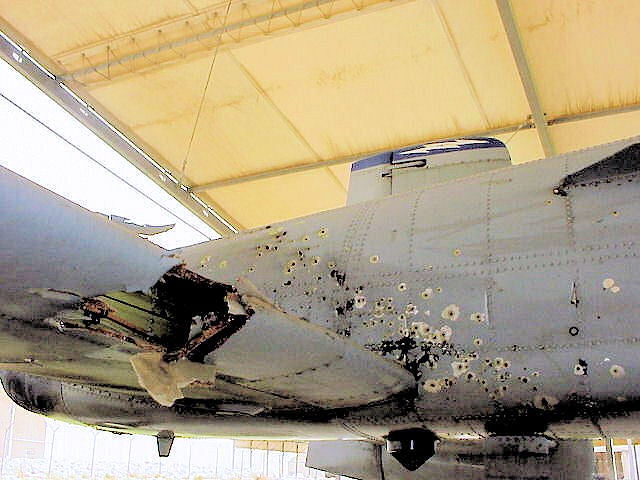
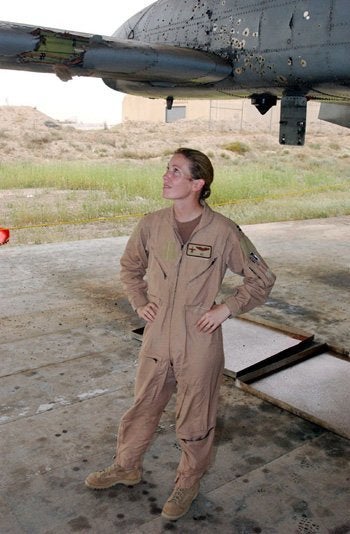
Captain Kim Campbell, certified Badass.
 "facw" (facw)
"facw" (facw)
05/19/2017 at 12:55, STARS: 1
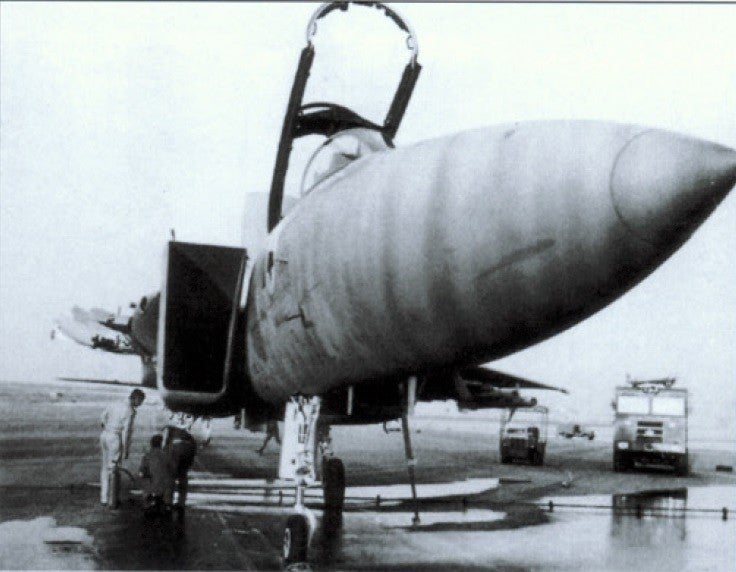
 "ttyymmnn" (ttyymmnn)
"ttyymmnn" (ttyymmnn)
05/19/2017 at 12:58, STARS: 0
How in the hell did that thing even stay in the air?!

05/19/2017 at 13:04, STARS: 0
The pilot punched the ‘burners, and got enough lift off the fuselage and intakes. The IAF even managed to repair the plane (basically remove the scrap and bolt on a new right wing):
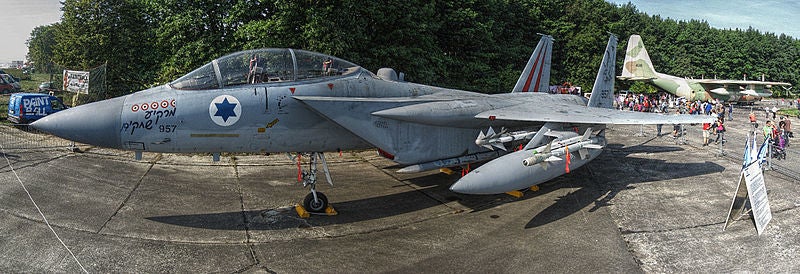
 "S65" (granthp)
"S65" (granthp)
05/19/2017 at 13:05, STARS: 0
Beat me to it!
 "ttyymmnn" (ttyymmnn)
"ttyymmnn" (ttyymmnn)
05/19/2017 at 13:06, STARS: 0
I can only imagine what his landing speed was like.
 "S65" (granthp)
"S65" (granthp)
05/19/2017 at 13:11, STARS: 0

05/19/2017 at 13:20, STARS: 1
260kts, and he stopped about ten meters shy of the arresting barrier.

Best part is, neither the PIC nor the instructor realized the wing was gone until they landed.
 "Smallbear wants a modern Syclone, local Maple Leafs spammer" (smallbear94)
"Smallbear wants a modern Syclone, local Maple Leafs spammer" (smallbear94)
05/19/2017 at 13:27, STARS: 1
With the advent of the Boeing 707 and Douglas’ own DC-9 , sales of the DC-7 ground to a halt by the end of the 1950s.
Typo? DC-8, no?
!!! UNKNOWN CONTENT TYPE !!!
On the Gorky, that first crash was completely idiotic. It was a flyover of a parade on a holiday, with factory workers and their families on board as a reward. It was flying in formation with an I-15 fighter piloted by an egotistic moron. The I-15 pilot was flying very close to the Gorky, and the pilot of the Gorky asked him to give him some more space. So of course the logical thing to do was say to the Gorky pilot “I’ll show you how good a pilot I am” and proceed to loop around the wingtip of the Gorky, right? ...his engine stalled on the top of the loop. The rest is history.
!!! UNKNOWN CONTENT TYPE !!!
Awesome as usual, keep ‘em coming! :)
 "For Sweden" (rallybeetle)
"For Sweden" (rallybeetle)
05/19/2017 at 13:35, STARS: 0
“Israeli physics”
-Nazis.
 "ttyymmnn" (ttyymmnn)
"ttyymmnn" (ttyymmnn)
05/19/2017 at 14:14, STARS: 1
Yes, DC-8. Derp. For some reason, I keep thinking that the -9 was the first jet. I make that mistake often.
Awesome as usual, keep ‘em coming! :)
Thanks! I’m almost a month ahead now on writing these things. I need to cover for my summer vacations.
 "Kiltedpadre" (kiltedpadre)
"Kiltedpadre" (kiltedpadre)
05/19/2017 at 15:49, STARS: 1
Unless they have a recurring liver condition.
 "You can tell a Finn but you can't tell him much" (youcantellafinn)
"You can tell a Finn but you can't tell him much" (youcantellafinn)
05/19/2017 at 16:10, STARS: 0
The Israeli’s have developed some unusual weapons systems. They’ve also come up with some interesting modifications to existing weapons systems that they’ve purchased from other countries. One of the more fascinating developments was the use of early (pre F-15E) F-15's for the long range strike mission. You have to wonder if Operation Wooden Leg made it easier for MD to sell the USAF on the use of the F-15 as a long range strike fighter.
In other news apparently the Navy flew the Kfir for a few years.
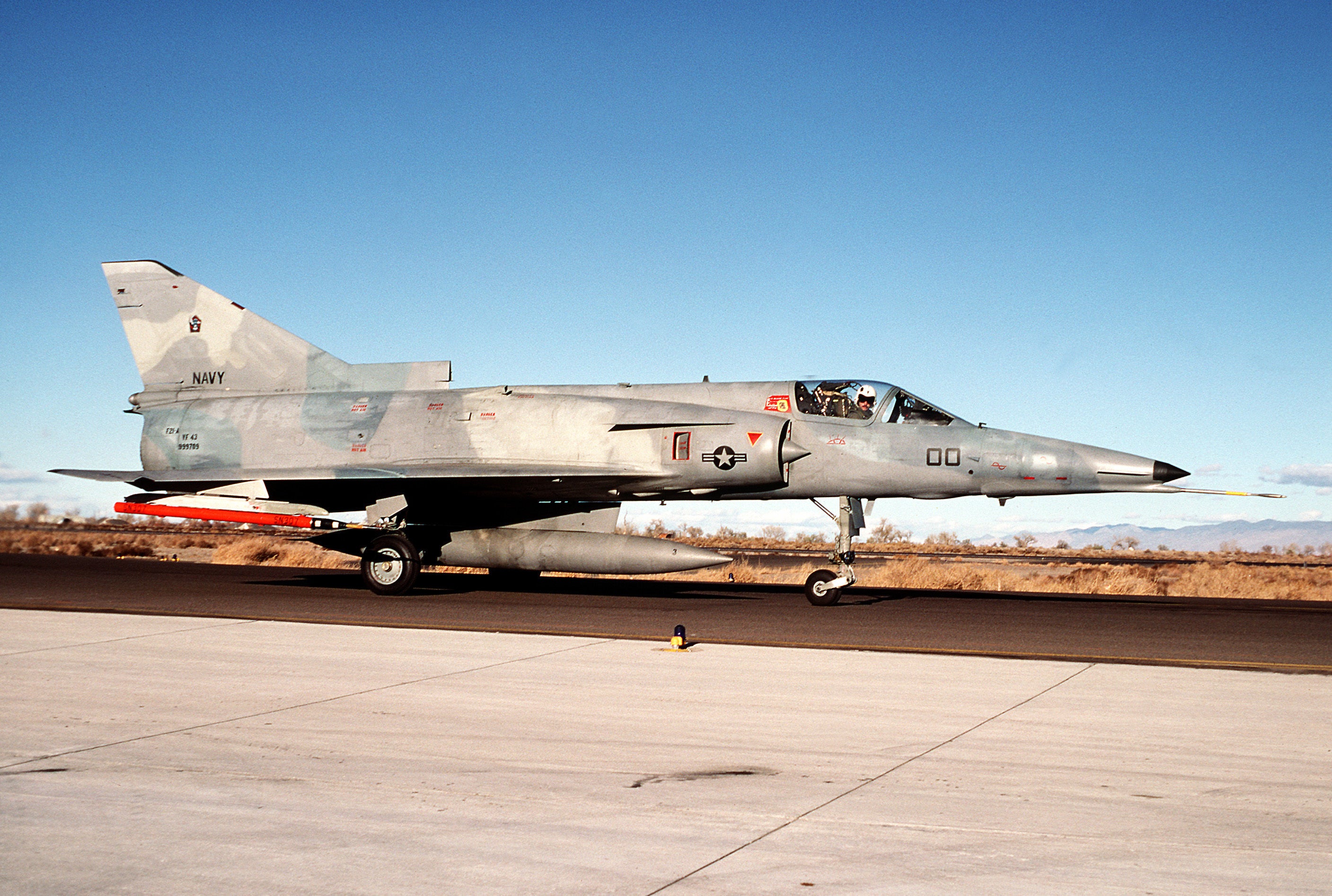
ETA: Link to another article on Operation Wooden Leg and the F-15's that were used http://www.freerepublic.com/focus/news/3287888/posts . Also stealth edit because my first go round had way too many interestings in close proximity.
 "ttyymmnn" (ttyymmnn)
"ttyymmnn" (ttyymmnn)
05/19/2017 at 16:15, STARS: 0
The Navy did fly them. I used to live in Norfolk, VA, near Oceana NAS. I used to see Kfirs overhead. Pretty cool.